Use of interfering RNA to investigate the role of endogenous gastrin in the survival of gastrointestinal cancer cells
- PMID: 17262081
- PMCID: PMC2360027
- DOI: 10.1038/sj.bjc.6603588
Use of interfering RNA to investigate the role of endogenous gastrin in the survival of gastrointestinal cancer cells
Abstract
Gastrin isoforms, acting through a variety of receptors, have proliferative and anti-apoptotic effects on gastrointestinal (GI) cancers. A small interfering RNA (siRNA) targeting the gastrin gene was used to investigate the role of endogenous gastrin in GI cancer cell survival. Downregulation of the gastrin gene in siRNA-transfected cells was measured using real-time reverse transcriptase-PCR. The most effective siRNA was tested in a panel of GI cancer cell lines at various concentrations and time points, and the effect on cell survival and apoptosis was measured using methyl thiazoyl tetrazolium (MTT) and caspase 3 activation assays. Gastrin siRNA reduced gene expression by more than 90% in a range of GI cancer cell lines. Downregulation of the gastrin gene was dose-dependent and effective over approximately 1 week in vitro. However, downregulation at the protein level was delayed by 3-4 days. Gastrin siRNA-transfected cells showed up to a 60% reduction in growth and up to a 50% increase in apoptosis compared with control siRNA-transfected cells. The effects were most marked in the cell line with the highest constitutive level of gastrin gene expression (human metastatic colon, C170HM2) and in epidermal growth factor (EGF)-treated cells as the gastrin promoter contains an EGF-response element, gERE. The ability of the siRNAs to reduce survival of these GI cell lines is further evidence of the importance of autocrine and/or intracrine gastrin loops in GI cancer, where expression of the gastrin gene and autonomous gastrin appears widespread.
Figures
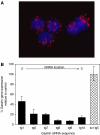
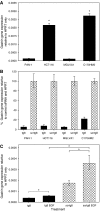
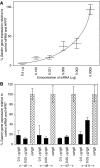
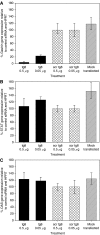




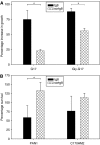
Similar articles
-
Helicobacter pylori can induce heparin-binding epidermal growth factor expression via gastrin and its receptor.Cancer Res. 2006 Aug 1;66(15):7524-31. doi: 10.1158/0008-5472.CAN-05-3246. Cancer Res. 2006. PMID: 16885350
-
Small interference RNA targeting heat-shock protein 27 inhibits the growth of prostatic cell lines and induces apoptosis via caspase-3 activation in vitro.BJU Int. 2006 Nov;98(5):1082-9. doi: 10.1111/j.1464-410X.2006.06425.x. Epub 2006 Jul 28. BJU Int. 2006. PMID: 16879439
-
Proliferation suppression and apoptosis of ovarian carcinoma cells induced by small interfering RNA against vascular endothelial growth factor.J Obstet Gynaecol Res. 2010 Apr;36(2):232-8. doi: 10.1111/j.1447-0756.2010.01196.x. J Obstet Gynaecol Res. 2010. PMID: 20492371
-
Role of progastrins and gastrins and their receptors in GI and pancreatic cancers: targets for treatment.Curr Pharm Des. 2004;10(19):2345-58. doi: 10.2174/1381612043383999. Curr Pharm Des. 2004. PMID: 15279613 Review.
-
EGF receptor activation of the human gastrin gene: a tale of two zinc finger transcription factor families.Keio J Med. 2000 Sep;49(3):106-10. doi: 10.2302/kjm.49.106. Keio J Med. 2000. PMID: 11029879 Review.
Cited by
-
Cholecystokinin and pancreatic cancer: the chicken or the egg?Am J Physiol Gastrointest Liver Physiol. 2014 Jan;306(2):G91-G101. doi: 10.1152/ajpgi.00301.2013. Epub 2013 Oct 31. Am J Physiol Gastrointest Liver Physiol. 2014. PMID: 24177032 Free PMC article. Review.
-
A HIF-independent, CD133-mediated mechanism of cisplatin resistance in glioblastoma cells.Cell Oncol (Dordr). 2018 Jun;41(3):319-328. doi: 10.1007/s13402-018-0374-8. Epub 2018 Feb 28. Cell Oncol (Dordr). 2018. PMID: 29492900 Free PMC article.
-
Activation of pro-oncogenic pathways in colorectal hyperplastic polyps.BMC Cancer. 2013 Nov 8;13:531. doi: 10.1186/1471-2407-13-531. BMC Cancer. 2013. PMID: 24209454 Free PMC article.
-
Anti-Gastrins Antiserum Combined with Lowered Dosage Cytotoxic Drugs to Inhibit the Growth of Human Gastric Cancer SGC7901 Cells in Nude Mice.J Cancer. 2015 Mar 8;6(5):448-56. doi: 10.7150/jca.11400. eCollection 2015. J Cancer. 2015. PMID: 25874008 Free PMC article.
-
A gastrin transcript expressed in gastrointestinal cancer cells contains an internal ribosome entry site.Br J Cancer. 2008 May 20;98(10):1696-703. doi: 10.1038/sj.bjc.6604326. Epub 2008 Apr 8. Br J Cancer. 2008. PMID: 18392051 Free PMC article.
References
-
- Ahmed S, Budai B, Heredi-Szabo K, Farkas J, Toth G, Murphy RF, Lovas S (2004) High and low affinity receptors mediate growth effects of gastrin and gastrin-Gly on DLD-1 human colonic carcinoma cells. FEBS Lett 556: 199–203 - PubMed
-
- Aoki Y, Cioca DP, Oidaira H, Kamiya J, Kiyosawa K (2003) RNA interference may be more potent than antisense RNA in human cancer cell lines. Clin Exp Pharmacol Physiol 30: 96–102 - PubMed
-
- Baba M, Itoh K, Tatsuta M (2004) Glycine-extended gastrin induces matrix metalloproteinase-1- and -3-mediated invasion of human colon cancer cells through type I collagen gel and Matrigel. Int J Cancer 111: 23–31 - PubMed
-
- Baldwin GS (1995a) Binding of progastrin fragments to the 78 kDa gastrin-binding protein. FEBS Lett 359: 97–100 - PubMed
-
- Baldwin GS (1995b) The role of gastrin and cholecystokinin in normal and neoplastic gastrointestinal growth. J Gastroenterol Hepatol 10: 215–232 - PubMed
MeSH terms
Substances
LinkOut - more resources
Full Text Sources
Other Literature Sources
Research Materials

